|
|
|
| |
|
|
| |
Salmon Fishing Ends at Forvie |
|
| |
| |
| This video
clip is part of a programme called 'Redfish' which
documents the last season of salmon fishing at Forvie. |
| |
|
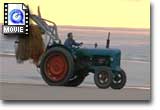 |
| |
|
|
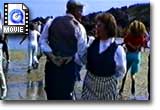 |
| The
Lang Reel of Collieston |
| |
| This re-enactment
was staged as part of the celebrations to mark the
updating of the Collieston Harbour Act of 1894 with
the Collieston Harbour Revision Order 1991. |
| |
| The traditional
musicians from the band Hallyracket who provided the
music, also researched the dance steps. |
| |
|
|
| |
|
|
| |
Rescue
at Sea |
|
| |
| |
Four members
of the Collieston Auxiliary Coastguard Company received
a commendation and special medallion from Gordon District
Council for their part in the rescue of Paul Forbes
on May 13 1993 after he had been washed into heavy
seas from rocks at the Needle’s E’e, Cransdale.
HM Coastguard in Aberdeen was alerted and the Company
from Collieston was called out to assist with the
rescue. Treacherous sea conditions at Collieston harbour
meant that a boat had to be launched instead from
the beach at Cransdale.
From the vantage point on top of the Needle’s
E’e, John directed his colleagues by radio to
where Paul was trying to keep afloat about one hundred
yards offshore. While Robin controlled the boat, Malcolm
and Jack managed to haul the boy on board. A search
and rescue helicopter from RAF Lossiemouth soon appeared
and Paul was winched on board and flown to hospital
in Aberdeen. He was found to be in the early stages
of hypothermia but otherwise OK.
|
| |
|
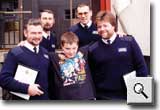 |
| |
|
|
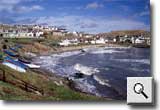 |
| Harbour
View |
| |
The harbour
and beach circa 1997, as well as the areas known as
Low Town and the Cliff. The small boats berthed on
the left, above the area of the beach known as the
‘boatie shore’, are still used for fishing
but now only as an enjoyable pastime.
The houses have all been modernised and many of them
have also had the living areas extended by the addition
of dormer windows upstairs and conservatories at ground
level. The house in which Lawrence of Arabia stayed
in 1930 stands out in the centre of the top third
of the photograph. It is painted white with a raised
roof and much-enlarged gable.
The row of cottages built in 1887, originally known
as Jubilee Terrace to commemorate the Golden Jubilee
of Queen Victoria, are clearly visible centre left.
|
| |
|
|
| |
|
|
| |
Major
Road Repairs |
|
| |
| |
In 1991,
cracks appeared in the road and pavement bordered
by a wooden fence above the area of Collieston known
as the Bog. The cracks grew larger by the day and
a survey was commissioned. It concluded that the upper
part of the village was slipping down into the Bog.
Major engineering works, financed by the local authority,
began to build a retaining wall.
In order to allow the trucks carrying the massive
steel piles to reach the work site a wooden road was
built along the shore and up into the Bog. Pile driving
equipment can be seen behind the white gabled house.
In the foreground there is an articulated lorry loaded
with piles. Parked alongside are three contractors’
white vans.
The work took some six months to complete and the
constant vibration of the pile driver caused widespread
minor cracking and damage to drains in surrounding
houses. |
|
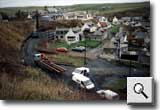 |
| |
|
|
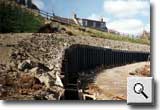 |
Looking
north along a track that was specially constructed
to allow pile-driving equipment to be brought in,
the tops of the steel piles can be seen in the trench
to the left of the track. Still under construction,
is the curved retaining wall. Above the wall the
slope is being landscaped to form a gentler gradient.
In the foreground is the shuttering for the reinforced
concrete that was poured to secure the piles.
|
|
|
| |
|
|
| |
Following
significant pile driving, the steel piles were screened
behind a massive curved wall built with synthetic
stone blocks. The gradient of the bank was landscaped
to make it less steep and the whole area of the
Bog was reinstated in grass, covering all signs
of the temporary roadways that had been used during
the construction phase.
A steel railing safety fence runs along the top
of the wall and a similar fence was built along
the pavement at the top of the slope.
|
| |
|
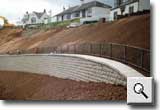 |
| |
|
|
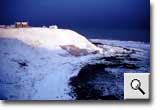 |
| Snowfall |
| |
December
1999 after a significant fall of snow. Looking northwards,
Slains Lodge is clearly visible standing on the cliff
above Perthudden. To the right of the Lodge is the
whitewashed building known as the ‘Lookout’.
The Lookout is now a private residence but was formerly
the lookout post for the Collieston Coastguard Company.
Slains Lodge was originally built from a mix of faced
granite and harled rough-cut local stone with a slated
roof. By the close of the 20th Century the building
had been converted from a hotel/shooting lodge of
some 30 rooms into 3 individual flats and a smaller
two-storey house in what had once been the public
bar and servants’ quarters.
|
| |
|
|
| |
|
|
| |
Fishing |
|
| |
| |
Three
men after an early morning fishing trip in 1999. To
the rear of the men, Ronnie Chaplain, Mike Wallace
and Ken Ingram, small boats are clearly visible tied
to moorings near the ‘boatie shore’ at
the foot of the Braehead.
Commercial fishing in Collieston is now a thing of
the past but it is still a popular pastime with both
residents and visitors alike, although it is now only
undertaken when the weather is fair and the sea calm.
Gone are the days when fishing boats had to be taken
out in all weathers and women had to carry their men-folk
out to the boats to prevent their leather sea boots
from getting wet.
Herring and flounders are still caught and there is
still a small private smokehouse in the village where
the herring are kippered. Speldings, however, are
no longer made and the days of Collieston’s
famous Spelding Teas have indeed passed into history.
|
| |
|
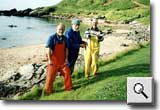 |
| |
|
|
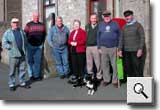
|
| The
“Fogies” |
| |
The Collieston
“Fogies” Arthur Green. Dave Stewart, Walter
Moncrieff, Islay Stott, Alex Ross, Steve Ritchie &
John Robertson
|
| |
|
|
| |
|
|
| |
Collieston
Village Shop in the 1990s
|
|
| |
| |
Alec
Ross (L) and Rear Admiral Steve Ritchie (R) outside
the Village Shop in 2000. Behind them seated on a
bench is Arthur Green with his dog Danny.
|
| |
|
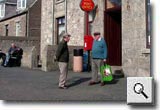
|
| |
|
|
| |
Education |
|
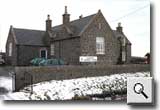 |
| |
Collieston
Community Centre was originally built as the village
school and opened as such in 1877. After a temporary
closure in 1922, due to a decrease in the school roll,
the school was finally closed on July 1, 1949.
As was common practice in small rural communities
in the latter part of the 20th Century the building
was altered internally to enable it to function as
an important focal point of village life and toilets
and a kitchen area were installed.
The house attached to the original school building,
formerly lived in by the headmaster and his family,
is now used as storage space for the various organisations
which use the building on a regular basis. These are
many and varied and include the Children’s Playgroup,
Over 60’s Club and Women’s Rural Institute.
|
| |
|
|
|
 |
|
| ....copyright
collieston's century 2003 |
|